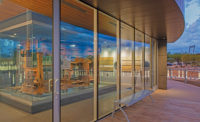T. Tyler Potterfield Memorial Bridge
Richmond
Best Project
Owner: City of Richmond
Lead Design Firm: Hargreaves Associates
General Contractor: Howard Shockey & Sons Inc.
Civil Engineer: VHB
Structural Engineer: Moffatt & Nichol
Construction Manager/Owner’s Representative: AECOM
Bridge Repair Consultant: Wagman Heavy Civil
Subcontractors: Bay Electric Co.; S.B. Cox Inc. (Demolition)
Before he died of a heart attack three years ago at the age of 55, T. Tyler Potterfield Jr. was instrumental in designing the first dedicated pedestrian and cycling bridge to cross Richmond’s James River. The bridge, dedicated in December 2016, was named after Potterfield, the senior planner for the Richmond Dept. of Planning and Development Review.
Despite opening during an unseasonably cold winter, the 1,700-ft-long and 10-ft wide bridge quickly became a landmark in Potterfield’s adopted city. In the first month the bridge was open, it drew 35,000 people, who enjoyed panoramic views of the Richmond skyline as they walked across a span that sits just 20 ft above the river’s falls.
Design and construction of the $11.3-million bridge, which links the city’s downtown to the revitalizing Manchester neighborhood, was complicated by its location within the river’s floodplain. The project’s permitting had to pass through five different state and federal agencies as well as the city. One of the project’s biggest challenges was a nearly four-month moratorium on work in the James River to protect local fish migration. A World Cup cycling race that shut down construction for three weeks was another major hurdle.
The team completed the 17-month project on time by implementing a top-down building approach. A custom gantry crane helped use the existing bridge structure for horizontal transport of materials while minimizing disruption to the riverbed and habitat below. A temporary work platform to receive new bridge elements was built with specially designed aluminum trusses from Sweden. The trusses span a 40-ft pier spacing.
Built on a decommissioned hydro power dam constructed around 1900, the bridge reused some existing piers that had significant damage, including concrete spalling and exposed reinforcement. A team of specialty divers surveyed the piers’ condition below the waterline before six of the existing piers were rehabilitated and one was fully reconstructed. “From a community standpoint this is fantastic,” one judge notes, “and reusing the old bridge piers, that’s pretty neat.”
The bridge is well-lit and secured, making its path accessible to the public at all hours of the day. The T. Tyler Potterfield Memorial Bridge stands to be a popular destination for Richmond’s recreational, social and cultural life for years to come.
Related Article: Region’s Best Work Meets Big Challenges








Post a comment to this article
Report Abusive Comment